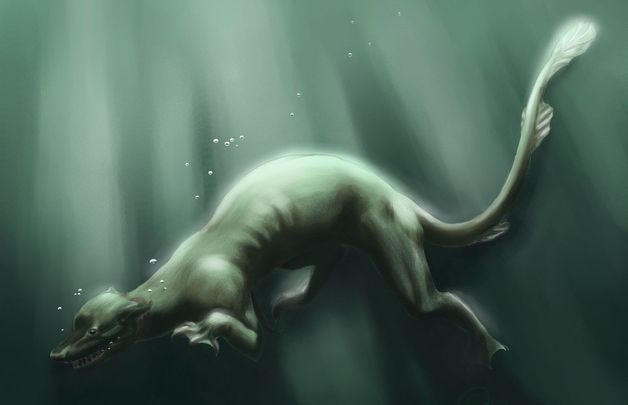Although Irish folklore is littered with legendary ghoulish water creatures, few are as scary as the Dobhar Chú (pronounced do-war coo). Considered by some to be Ireland’s version of the famous Loch Ness monster, the Dobhar Chú is a mythical lake monster that has inhabited the lakes of the British Isles since ancient times.
The name, Dobhar Chú, roughly translates to ‘water hound’, or ‘hound of the deep’. Thought to be a cross between a giant otter and a hound, the Dobhar Chú is about seven feet long, or about the size of a crocodile. In fact, it is also known as the Irish Crocodile.
The Dobhar Chú is a bloodthirsty, gruesome creature that lives deep in the waters of lakes, rivers, or even the sea and is known to travel great distances in water or on land. This monster hound is known for its speed, aggression, and appetite for human flesh. There are usually two of these creatures, and when one is killed, its mate will swim up from the depths and avenge the death by pursuing its attacker, killing him, and often eating him. This happens because, when the Dobhar Chú is about to die, it gives off an eerie high-pitched whistle to warn its mate.
Like the legendary Bigfoot and many other creatures, the Dobhar Chú is known as a cryptid, a term for a creature or plant whose existence is not recognized by scientific consensus and is usually regarded as highly unlikely. Yet in Glenade, County Leitrim, in north-west Ireland, there is evidence to suggest its existence.
Reports of Dobhar Chú sightings date back as far as 1684. Miss Walkington recorded one in the 1896 edition of The Journal of the Royal Society of Antiquaries of Ireland. Miss Walkington described it as being ‘half-wolf-dog and half-fish’. A few months after the war, Mr. H. Chicester Hart responded to Miss Walkington’s letter. He said he had heard rumors of a gruesome creature called the Dobhar Chú, which is said to be the king of all lakes and the father of all otters.
The creature is believed to live in many lakes around Ireland. Sraheens Lough, Achill Island, in County Mayo, is where the most significant number of, as yet, unsubstantiated modern sightings in Ireland have been. A small population of Dobhar Chú live in Sraheens Lough, though it is believed they are migratory, not living in the lake year-round.
As recently as 2000, Irish artist Sean Corcoran and his wife claimed to have witnessed a Dobhar Chú in a lake on Omey Island in Connemara, County Galway. Corcoran describes it as large, dark, and with orange flippers. “The creature,” reports Corcoran, “swam the width of the lake from west to east in what seemed like a matter of a few seconds.” Corcoran concludes that it finally leapt onto a huge boulder, and before disappearing, gave “the most haunting screech.
More frightening than the Selkies (seals that can take the form of humans) or the famous Kelpies (mythical water horses said to inhabit the rivers and lakes of Scotland and Ireland), the Dobhar Chú is considered an immature form of the famous Lough Ness monster, affectionately known as Nessie.
There is also an interesting link between Ireland and these two monsters that continues to this day. The link begins with the first sighting of the Loch Ness monster in Scotland in the 7th century by the Irish missionary St. Columba. Columba was also the first to challenge and overcome the Loch Ness monster; by using his spiritual powers, Columba miraculously saved a man from being devoured by the beast. This story leads to another myth that Nessie’s offspring came to the lakes of Ireland to avenge St. Columba’s actions.
Lest you think that the Dobhar Chú is just another imaginary fable, be aware that there is some evidence to suggest it may be real. What is more, another theory suggests that this creature travels extensively.
Some researchers, for example, connect the famous lake monster Bessie, said to inhabit Lake Erie in the US, to the Irish Dobhar Chú. There have been several sightings of this large serpentine monster, which followed Irish emigrants to the heartland of America.
An unconfirmed sighting of Bessie describes a terrifying encounter with a vast lake creature that killed three people in 1992. A more elusive but similar sinister creature has apparently been attacking swimmers at Pump House Beach near Port Dover, Canada, since August 2001. Other reports document that these creatures inhabit scattered locations across New England and the Great Lakes region.
However, of all the sightings of the Dobahr Chú, it is the account in Glenade, County Leitrim, of 1722 of the bestial murder of Grace McGloighlin that is the most famous. Oral tradition in this part of Ireland still holds that the story of The Dobhar Chu of Glenade is true. This is the story as related by local storyteller Owen McGowan of the townland of Ahanlish, Kinlough, Co. Leitrim.
Grace McGloighlin, known as Grace or Gráinne Connolly (the custom at the time was that a woman retained her maiden name after marriage), lived in the townland of Creevelea, which is close to the border of Leitrim and Sligo, and on the northwestern part of Glenade Lake. On September 22, 1722, Grace came down to the lake to bathe and perhaps wash some clothes. While she was doing this, a giant monster emerged from the water and savagely attacked, then killed Grace. She was later found by her husband, Terence. Terence saw her bloodied body on the side of the lake and, to his horror, saw the giant beast that had killed his wife lying asleep across her dead body. Heartbroken with grief and furious, Terence knew at once that it was a Dobhar Chú.
Terence immediately found his dagger and killed the monster. However, as is usual with this kind of creature, during its death throes, it let out a high-pitched whistle which alerted its mate to what was happening. A second Dobhar Chú emerged at once from the depths of the lake. Terrified, Terence took to his heels and, jumping on a horse, began to ride for his life as the second Dobhar Chú pursued him. Terence rode for many miles, with the Dobhar Chú close behind him. A local man, Patrick Doherty (now deceased), told historian and folklorist Joe McGowan the story of the chase. It started at Frank McSharry’s of Glenade, faltered, and ended close by Cashelgarron stone fort in Co. Sligo at a blacksmith’s forge.
After being chased for miles, Terence was obliged to stop to have his horse’s foot re-shod. The blacksmith at Cashelgarron, a wise man, knew the ways of this creature. He gave Terence a sword and told him, “When the creature charges, he’ll put his head right through the horse. As soon as he does this, you be quick and cut his head off.”
Terence, still on his horse, stood his ground near the forge. The colossal beast came at full charge, and then it put its head right through the horse, as predicted by the blacksmith. This time, however, Terence was ready. Determined to avenge his wife’s murder, Terence put his sword through the Dobhar Chú’s head, killing it instantly.
There is further ghoulish detail to back up the story. The grave of Grace Connolly actually exists. What’s more, carved on her tombstone is a detailed depiction of her killer, the Dobhar Chú. It is located in Conwall cemetery in the townland of Drummans, in County Limerick. Drummans near the village of Kinlough is part of the approach to the Glenade Valley.
The tomb itself is so old that most of the written details are illegible. However, Grace’s name and her husband's can be made out. The carved image of the Dobhar Chú is much clearer. The creature is depicted lying down with its head and neck flung backward so that it lies flat along its back in its death throes. A spear-like weapon is shown piercing the base of the creature’s neck, reemerging below its body, and gripped by a human fist at its upper end.
Also, and less well known, both the Dobhar Chú and McGloighlin’s horses are buried in Co. Sligo, not far from Cashelgarron stone fort, where they were both killed.
* This article first appeared in the January / February 2013 issue of Ireland of the Welcomes and was updated here in December 2025.




Comments